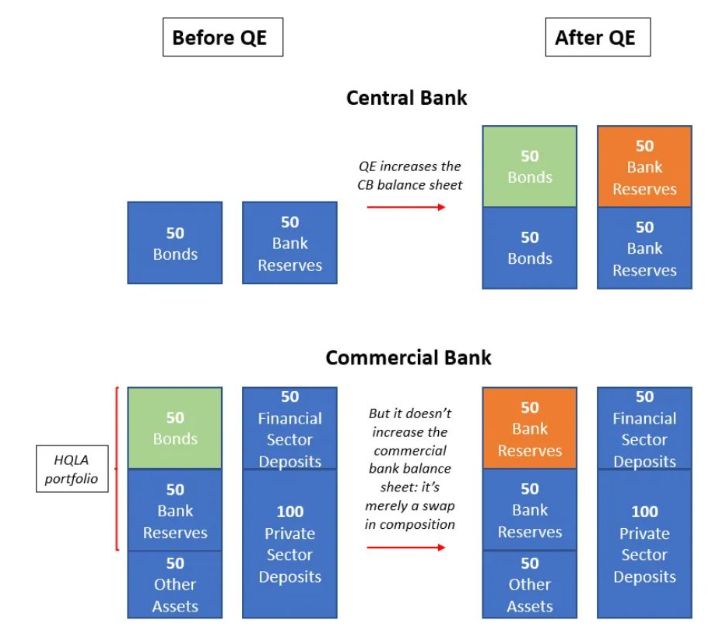If long-end bond yields spiral out of control, the Fed could start injecting liquidity again: a step-by-step guide of how it works.
When a few weeks ago 30-year bond yields briefly flirted with the 5% level, the Fed’s Collins released an interview stating that ’’the Fed is absolutely ready to stabilize markets’’.
To stabilize the bond market, they would ’’inject liquidity’’ through operations like the LSAP - Large Scale Asset Purchase or QE.
Central Banks create bank reserves when they perform such operations.
Bank reserves are often referred to as ’’Liquidity’’.
When Central Banks engage in liquidity creation, they do that in the hope that it activates the so-called Portfolio Rebalancing Effect.
To understand this, let’s start from what QE does to the balance sheet of a commercial bank - take a look at the chart below.
Following the GFC, regulators forced banks to own more HQLA (high-quality liquid assets) to meet depositor outflows.
Bank reserves and bonds qualify as ’’HQLA’’ as they are liquid enough to be converted into cash to meet potential outflows quickly.
But banks are not indifferent between owning bank reserves and bonds, and especially if the amount of reserves grows dramatically as a result of QE.
Bank reserves are a zero-duration and low-yielding instrument that can be suboptimal to own in large sizes, especially if compared with bonds, which offer higher returns and duration hedging properties.
And this is when the Portfolio Rebalancing Effect kicks in.
- Once QE starts, Central Banks take away bonds and inject new reserves into the banking system.
- Loaded with suboptimal reserves, banks will try to switch back the composition of their portfolios towards more bonds.
- They will bid up safer bonds first, and bid up riskier bonds later when the hunt for returns intensifies.
This will kick in a virtuous cycle of low volatility and a hunt for riskier assets: the Portfolio Rebalancing Effect in action.

Summarizing:
- Central Banks expand their balance sheet and purchase bonds
- Commercial Banks are on the receiving end of QE, and hence their portfolio composition tilts towards more reserves and less bonds.
- But reserves are sub-optimal to own compared to regulatory-friendly bonds, and hence, they look to rebalance their portfolios.
- They start buying the very same bonds QE is buying, hence suppressing volatility further and compressing credit spreads.
- Asset allocators and investors across the world are more and more encouraged to take additional risks in their portfolios, supporting the flow of credit and capital.
Does the Portfolio Rebalancing Effect make sense to you?
Which stock should you buy in your very next trade?
With valuations skyrocketing in 2024, many investors are uneasy putting more money into stocks. Unsure where to invest next? Get access to our proven portfolios and discover high-potential opportunities.
In 2024 alone, ProPicks AI identified 2 stocks that surged over 150%, 4 additional stocks that leaped over 30%, and 3 more that climbed over 25%. That's an impressive track record.
With portfolios tailored for Dow stocks, S&P stocks, Tech stocks, and Mid Cap stocks, you can explore various wealth-building strategies.

